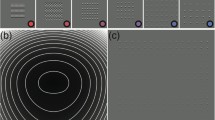Abstract.
It is shown that contrast interrelation functions for small compound gratings and for small compound edge-type patterns have different shapes: the former are lozenges, the latter ellipses in the normalised contrast space. These findings can be described by a simple p-norm model, comprising one channel which is most sensitive to the first pattern, another channel which is most sensitive to the second pattern and a non-linear summation of the channel outputs. Since the value of the summation exponent p is constant within but varies between pattern classes, an interpretation of the model parameters is limited to pattern class. Channel models based on the p-norm are discussed, taking into account the interpretation of the first derivative of the contrast interrelation function and the summation exponent, p.
Similar content being viewed by others
Author information
Authors and Affiliations
Additional information
Received: 8 December 1997 / Accepted in revised form: 15 October 1999
Rights and permissions
About this article
Cite this article
Meinhardt, G. Detection of compound spatial patterns: further evidence for different channel interactions. Biol Cybern 82, 269–282 (2000). https://doi.org/10.1007/s004220050581
Issue Date:
DOI: https://doi.org/10.1007/s004220050581




